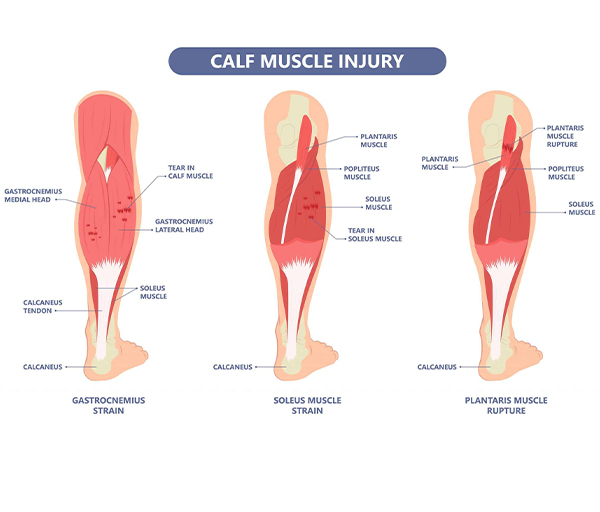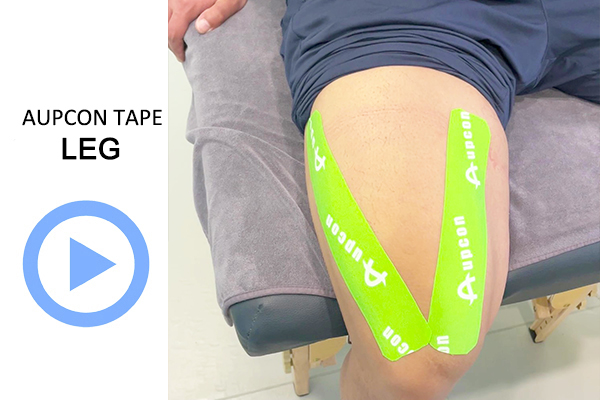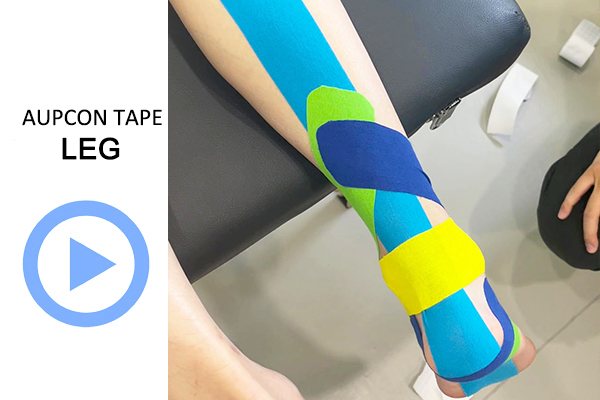Wie verwendet man Kinesiologie-Tape bei Wadenmuskelschmerzen?
Schmerzen in der Wadenmuskulatur
Im Allgemeinen haben Menschen, die gerne laufen, oft eine übermäßige Aktivität in ihren Wadenmuskeln, was zu übermäßiger Muskelermüdung und Ansammlung von Milchsäure in den Zellen führt, was am Tag nach dem Laufen zu Muskelkater führt. Daher sollten Patienten die Aktivität des betroffenen Glieds reduzieren, mehr auf Ruhe achten und das in diesem Tutorial beschriebene Kinesiologie-Tape für die Wadenmuskulatur verwenden, um die Durchblutung zu beschleunigen und Schmerzen zu lindern.
TIPPS ZUM TAPEN VON KINESIOLOKEN
- Reinigen Sie Ihre Haut vor dem Anbringen, um die Lebensdauer des Kinesiologie-Tapes für die Beine zu verlängern.
- Um einen sicheren Sitz zu gewährleisten, schneiden Sie die vier Ecken mit einer Kinesiologie-Tape-Schere ab, um ein Herunterfallen zu verhindern.
- Berühren Sie beim Aufbringen des Klebebands nicht die Klebefläche, um die Klebrigkeit nicht zu beeinträchtigen.
- Nach dem Anbringen das Bein-Kinesiologie-Tape mehrmals abwischen, um die Klebrigkeit zu aktivieren.
- Vermeiden Sie längeren Gebrauch und ersetzen Sie es innerhalb von 3–7 Tagen.
- Wenn eine offene Wunde an der Wade vorhanden ist, tragen Sie das Mittel nicht auf die Stelle auf.
Wie verwendet man Kinesiologie-Tape bei Wadenmuskelschmerzen?
Wählen Sie das erste krallenförmige Kinesiologie-Tape für die Wadenmuskulatur aus und befestigen Sie die Unterseite als Ankerpunkt an der rechten Seite der Wade.
Spannen Sie dann das Kinesiologie-Tape mit vier Krallen für die Wadenmuskulatur 75% und wickeln Sie es um die Wade.
Führen Sie die Muskelbandage des rechten Beins durch.
Kleben Sie die Unterseite der zweiten Kralle mit Kinesiologie-Tape gegen Wadenschmerzen als Ankerpunkt auf die linke Seite der Wade.
Dehnen Sie dann das Kinesiologie-Taping 75% gegen Wadenschmerzen und wickeln Sie es um die Wade.
Fertigen Sie die beiden krallenförmigen Bänder an und umwickeln Sie die Wadenmuskulatur über Kreuz.
Klicken Sie hier, um das vollständige Video zur Anwendung des Kinesiologie-Tapes an der Wade anzuzeigen.
Was ist ein Kinesiologie-Tape für die Wadenmuskulatur?
Die wichtigsten Effekte des Kinesiologie-Tapes für die Wadenmuskulatur
1. Stützen Sie die Beinmuskulatur und reduzieren Sie den Druck auf den Körper.
2. Schmerzen lindern und Verletzungen reduzieren.
3. Fördert die Durchblutung und beschleunigt die Lymphdrainage.
4. Reduziert Schwellungen und Entzündungen und unterstützt die Genesung.
Hauptanwendungen von Kinesiologie-Tape für die Wadenmuskulatur
Kinesiologisches Taping gegen Wadenschmerzen wird häufig zur Behandlung von Waden, Gastrocnemius, Wadenzerrungen, Achillessehnenschmerzen, Beinkrämpfen, Schmerzen an der Außenseite des Unterschenkels usw. eingesetzt.
Bei Auftreten allergischer Hautsymptome bitte die Anwendung beenden!
Kinesiologie-Tape aus Baumwolle
für die Wadenmuskulatur
→
Häufig gestellte Fragen
Im Allgemeinen können Schmerzen in der Wadenmuskulatur nach dem Laufen durch fehlende Aufwärmübungen, übermäßiges Training, Milchsäureansammlung, Weichteilverletzungen, Fasziitis usw. verursacht werden. Sie sollten entsprechend den spezifischen Gründen behandelt werden.
1. Keine Aufwärmübungen machen: insbesondere wenn die Umgebung relativ kalt und das Trainingsfeld relativ komplex ist und die oben genannten Symptome durch unzureichendes Aufwärmen vor dem Training verursacht werden.
2. Übermäßiges Training: Die Ursache kann übermäßiges Training sein. Es wird empfohlen, sich mehr auszuruhen und die tägliche Trainingsmenge zu kontrollieren.
3. Milchsäureansammlung: Dieses Symptom kann dadurch verursacht werden, dass die Muskeln nach langem Laufen nicht massiert und entspannt werden, was zu einer Ansammlung von Milchsäure führt.
Wenn die oben genannten Symptome auftreten, empfiehlt es sich, die Beine nach dem Laufen entsprechend zu massieren und die Beine mit einem Kinesiologie-Tape gegen Wadenschmerzen zu fixieren, was zu einer schnellen Entspannung der Muskulatur beiträgt.
Ja, Physiotape ist bei der Schmerzlinderung in der Wade wirksam. Es ist eine hervorragende Ergänzung zur Physiotherapie, lindert Beschwerden, fördert die Genesung und verhindert eine weitere Belastung der Wadenmuskulatur, während die Beweglichkeit erhalten bleibt.
Schmerzlinderung: Physio Tape hilft bei der Linderung von akuten und chronischen Muskelschmerzen im Beinbereich.
Muskelunterstützung: Physio-Tape stabilisiert verletzte oder überbeanspruchte Beinmuskeln und reduziert so die Belastung des Körpers.
Verbesserte Durchblutung und Lymphdrainage: Physio-Tape verbessert die Durchblutung, indem es die Haut anhebt und so den Raum für Blut- und Lymphgefäße vergrößert.
Hilft, Schwellungen und Entzündungen zu reduzieren und beschleunigt den Heilungsprozess.
Verletzungsprävention: Physio-Tape bietet zusätzlichen Halt beim Laufen und verringert das Risiko einer erneuten Verletzung oder verstärkter Beinschmerzen.
Ja, Sie können Ihren gezerrten Wadenmuskel umwickeln. Auch die in diesem Tutorial beschriebene Methode mit Kinesiologie-Tape für die Wadenmuskulatur kann hilfreich sein. Das Umwickeln hilft, die Schwellung zu reduzieren und bietet Halt. Der sanfte Druck des Tapes kann Beschwerden lindern und die Heilung fördern.
Im Allgemeinen wenden wir Kinesiologie-Tape für die Wadenmuskulatur an, es ist angenehm und hinterlässt kein Spannungsgefühl. Bei bestimmten Gelenken, wie etwa am Knöchel, kann jedoch für die Wirkung ein etwas stärkerer Druck erforderlich sein.
25-50% Spannung: zur allgemeinen Unterstützung, Schmerzlinderung und verbesserten Durchblutung.
50-75% Spannung: zur strukturellen Unterstützung oder gezielteren Anwendungen.
Die Enden des Kinesiologie-Tapes für die Wadenmuskulatur (Ankerpunkte) stehen immer unter Spannung, um einen übermäßigen Zug auf der Haut zu vermeiden.
Das Taping sollte sich mit der Haut und den Muskeln bewegen. Wenn es sich eng anfühlt, ist es möglicherweise zu eng.
Wenn sich das Kinesiologie-Tape an der Wade so eng anfühlt, dass es Unbehagen, Taubheit oder Kribbeln verursacht, kann es die Durchblutung beeinträchtigen und muss angepasst oder entfernt werden.
Andere Körperteile
Ich glaube, du hast gelernt Wie benutzt man Kinesiologisches Tape? um Ihnen zu helfen, Ihre Wadenschmerzen zu lösen. Wenn Sie mehr über andere Teile erfahren möchten, durchsuchen Sie bitte weiterhin die Tape-Anwendungen, die aktualisiert werden von AUPCON Hersteller von kinesiologischen Tapes!





